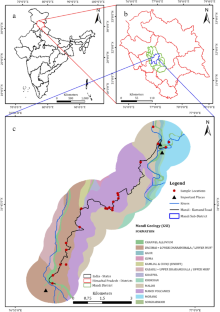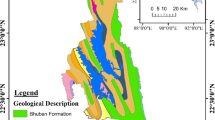Abstract
The slope failures cause significant damage, and the slope failure assessment can help understand the underlying factors contributing to these disasters. These disaster risks can be reduced through landslide monitoring and generating early warning alerts at vulnerable sites. Furthermore, the parameters to ascertain the instability for a given region were not explored. Therefore, criteria can be evaluated based on the understanding developed from local conditions, as it might be tedious to perform slope stability analysis for such large areas. Thus, an extensive site investigation was conducted in a study area subjected to numerous slope failures in Mandi, India. The primary goal of this study was to investigate the factors contributing to the slope failures. The present study was planned in the area anticipated for anthropogenic landslides due to construction activities. Hence, a series of geotechnical tests were performed, and the corresponding data from 26 soil samples obtained from different sites (with and without slope failures) of the Mandi region were employed for the current study. The geotechnical characteristics were determined using field and laboratory investigations from the collected soil samples, and thereby, their relationship with the slope failure occurrences was evaluated using multivariate correlation analysis. The results revealed that the most influential parameters for slope instability in this study area are saturated permeability, porosity, suction, in-situ density, in-situ water content and the angle of internal friction. Further, a comparison of these parameters, their critical values indicating failures have been presented with different study areas from the literature.








Similar content being viewed by others
Abbreviations
- SWRC:
-
Soil–water retention curve
- AEV:
-
Air entry value
- PDF:
-
Probability density function
- USCS:
-
Unified soil classification system
References
Ahmad F, Yahaya AS, Farooqi MA (2006) Characterization and Geotechnical Properties of Penang Residual Soils with Emphasis on Landslides. Am J Environ Sci 2(4):121–128. https://doi.org/10.3844/ajessp.2006.121.128
Akbas SO, Kulhawy FH (2010) Characterization and estimation of geotechnical variability in Ankara clay: a case history. Geotech Geol Eng 28:619–631. https://doi.org/10.1007/s10706-010-9320-x
Aloetti P, Chowdhury R (1999) Landslide hazard assessment: summary review and new perspectives. Bull Eng Geol Environ 58:21–44. https://doi.org/10.1007/s100640050066
ASTM D 422–63 (1994) Standard test method for particle size analysis of soils. Annual Book of ASTM Standards, 04(08) ASTM International, West Conshohocken, PA, USA.
ASTM D 5550–00 (2000) Test method for specific gravity of soil solids by gas pycnometer. Annual Book of ASTM Standards, 04(08) ASTM International, West Conshohocken, PA, USA.
ASTM D 6913 (2009) Standard test methods for particle-size distribution (gradation) of soils using sieve analysis. Philadelphia, USA.
ASTM D 4318 - 17e1 (2010) Standard Test Methods for Liquid Limit, Plastic Limit, and Plasticity Index of Soils. Philadelphia, USA.
ASTM D 698 - 12e2 (2012) Standard Test Methods for Laboratory Compaction Characteristics of Soil Using Standard Effort (12 400 ft-lb/ft3 (600 kN-m/m3)). Philadelphia, USA.
ASTM D 2216–19 (2019) Standard Test Methods for Laboratory Determination of Water (Moisture) Content of Soil and Rock by Mass. ASTM International, West Conshohocken, PA.
ASTM D2434–19 (2019) Standard Test Methods for Permeability of Granular soils. ASTM International, West Conshohocken, PA.
ASTM D3080 / D3080M-11 (2011) Standard Test Method for Direct Shear Test of Soils Under Consolidated Drained Conditions (Withdrawn 2020), ASTM International, West Conshohocken, PA.
Ballabio C, Sterlacchini S (2012) Support vector machines for landslide susceptibility map**: the Staffora river basin case study Italy. Math Geosci 44(1):47–70. https://doi.org/10.1007/s11004-011-9379-9
Bicocchi G, Tofani V, D’Ambrosio M, Tacconi-Stefaneeli C, Vannocci P, Casagli N, Lavorini G, Trevisani CF (2019) Geotechnical and hydrological characterization of hillslope deposits for regional landslide prediction modelling. Bull Eng Geol Environ 78:4875–4891. https://doi.org/10.1007/s10064-018-01449-z
Brooks RH, Corey AT (1964) Hydraulic properties of porous media. Hydrol. Paper 3. Colorado State Univ., Fort Collins, CO, USA.
Chaturvedi P, Thakur K, Mali N, Uday KV, Kumar S, Yadav S, Dutt V (2018). A low-cost IoT Framework for Landslide Prediction Risk Communication. In Internet of Things A to Z: Technologies and Applications (Ed: Quasy F. Hassan) IEEE-Wiley. https://doi.org/10.1002/9781119456735.ch21
Cao Z, Wang Y, Li D (2016) Quantification of prior knowledge in geotechnical site characterization. Eng Geol 203:107–116. https://doi.org/10.1016/j.enggeo.2015.08.018
Chen W, Reza H, Pourghasemi NSA (2018) Prioritization of landslide conditioning factors and its spatial modelling in Shangnan Country, China using GIS-based data mining algorithms. Bull Eng Geol Environ 77:611–629. https://doi.org/10.1007/s10064-017-1004-9
Corominas J, Van Westen C, Frattini P et al (2014) Recommendations for the quantitative analysis of landslide risk. Bull Eng Geol Environ 73:209–263. https://doi.org/10.1007/s10064-013-0538-8
Daniels RB, Hammer RD (1992) Soil Geomorphology. John Wiley & Sons Inc., Toronto
Dijkstra TA, Rogers CDF, Smalley IJ, Derbyshire E, ** LY, Min MX (1994) The loess of north-central china: Geotechnical properties and their relation to slope stability. Eng Geol 36(3–4):153–171. https://doi.org/10.1016/0013-7952(94)90001-9
Dikshit A, Satyam N, Towhata I (2017) Application of FlaIR model for an early warning system in Kalimpong, India for rainfall-induced landslides. Nat Hazards Earth System Sci. 295https://doi.org/10.5194/nhess-2017-295
Ellen SD, Fleming RW (1987) Mobilization of debris flows from soil slips, San Francisco Bay region, California. In: Costa JE, Wieczorek GF (eds), Debris flows/avalanches: Process, recognition and mitigation, Geological Society of America, Reviews in Engineering Geology 7:31–40. https://doi.org/10.1130/REG7-p31
Fredlund DG, **ng A (1994) Equations for the soil-water characteristic curve. Can Geotech J 31(4):521–532. https://doi.org/10.1139/t94-061
Fredlund DG, **ng A, Fredlund MD, Barbour SL (1996) The relationship of the unsaturated soil shear strength to the soil-water characteristic curve. Can Geotech J 33:440–448. https://doi.org/10.1139/t96-065
Fredlund, DG, Rahardjo H, Fredlund MD (2012) Unsaturated Soil Mechanics in Engineering Practice. John Wiley & Sons, Inc., New York (926 pp).
Giannecchini R, Pochini A (2003) Geotechnical influence on soil slips in the Apian Alps (Tuscany): First results in the Cardoso area. Proc. International Conference on Fast Slope Movements-Prediction and Prevention for Risk Mitigation, Napoli, Italy, March 11–13. 241–245.
Gupta SK, Shukla DP (2018) Application of drone for landslide map**, dimension estimation and its 3D reconstruction. Journal of the Indian Society of Remote Sensing 46:903–914. https://doi.org/10.1007/s12524-017-0727-1
Guzzetti F, Galli M, Reichenbach P, Ardizzone F, Cardinali M (2006) Landslide hazard assessment in the Collazzone area, Umbria, Central Italy. Nat Hazard Earth Syst Sci 6:115–131. https://doi.org/10.5194/nhess-6-115-200
Hall MA (1999) Correlation-based feature selection for Machine Learning. The University of Waikato.
Hugget RJ (1988) Soil chronosequences, soil development, and soil evolution. Critical Review Catena 32(3–4):155–172. https://doi.org/10.1016/S0341-8162(98)00053-8
Igwe O (2016) Predisposing factors and the mechanics of the rainfall-induced slope movements in Ugwueme, South-east Nigeria. Bull Eng Geology and the Environment 75:623–636. https://doi.org/10.1007/s10064-015-0767-0
Kim KS, Song YS (2015) Geometrical and geotechnical characteristics of landslides in Korean under various geological considerations. J Mt Sci 12(5):1267–1280. https://doi.org/10.1007/s11629-014-3108-z
Lumb P (1975) Slope failures in Hong Kong. Q J Eng Geol 8(1):31–65. https://doi.org/10.1144/GSL.QJEG.1975.008.01.02
Mali N, Uday KV (2016) Study of the effect of horizontal drains for slope stability, International Conference of Engineering Sustainable and Geotechnics, IIT Bombay, 12–18
Mali N, Chaturvedi P, Dutt V, Uday KV (2019) Training of Sensors for Early Warning System of Rainfall-Induced Landslides: IEREK Interdisciplinary Series for Sustainable Development Recent Advances in Geo-Environmental Engineering, Geomechanics and Geotechnics, and Geohazards. 449–452https://doi.org/10.1007/978-3-030-01665-4_104
Mali N, Dutt V, Uday KV (2021) Determining the Geotechnical Slope Failure Factors via Ensemble and Individual Machine Learning Techniques: A Case Study in Mandi, India. Front Earth Sci 9:701837. https://doi.org/10.3389/feart.2021.701837
McKenna JP, Santi PM, Amblard X, Negri J (2012) Effects of soil-engineering properties on the failure mode of shallow landslides. Landslides 9:215–228. https://doi.org/10.1007/s10346-011-0295-3
Mugagga F, Kakembo V, Buyinza M (2012) A characterisation of the physical properties of soil and the implications for landslide occurrence on the slopes of Mount Elgon. Eastern Uganda Natural Hazards 60(3):1113–1131. https://doi.org/10.1007/s11069-011-9896-3
Nebeokike UC, Igwe O, Egbueri JC et al (2020) Erodibility characteristics and slope stability analysis of geological units prone to erosion in Udi area, southeast Nigeria. Model Earth Syst Environ 6:1061–1074. https://doi.org/10.1007/s40808-020-00741-w
Sabrina CY, Rahardjo H, Satyanaga A (2019) Spatial variations of air-entry value for residual soils in Singapore. CATENA 174:259–268. https://doi.org/10.1016/j.catena.2018.11.012
Shepheard CJ, Vardanega PJ, Holcombe EA, Michaelides K (2018) Analysis of design choices for a slope stability scenario in the humid tropics. Engineering Sustainability, Proceedings of the ICE Publications 171(1):37–52. https://doi.org/10.1680/jensu.16.00081
Parkash S (2011) Historical records of socio-economically significant landslides in India. Journal of South Asia Disaster Studies 4(2):177–204. https://www.researchgate.net/publication/272905239
Pradhan SP, Panda SD, Roul AR, Thakur M (2019) Insights into the recent Kotropi landslide of August 2017, India: a geological investigation and slope stability analysis. Landslides 16:1529–1537. https://doi.org/10.1007/s10346-019-01186-8
Rahardjo H, Satyanaga A, D’Amore GAR, Leong EC (2012a) Soil-water characteristic curves of gap-graded soils. Eng Geol 125:102–107. https://doi.org/10.1016/j.enggeo.2011.11.009
Rahardjo H, Satyanaga A, Leong EC, Ng YS, Pang HTC (2012b) Variability of residual soil properties. Eng Geol 141:124–140. https://doi.org/10.1016/j.enggeo.2012.05.009
Todd KD (1980) Groundwater hydrology. Wiley, New York, p 535
Tofani V, Bicocchi G, Rossi G, Segoni S, D’Ambrosio M, Casagli N, Catani F (2017) Soil characterisation for shallow landslides modelling: a case study in the Northern Apennines (Central Italy) Landslides 14:755–770. https://doi.org/10.1007/s10346-017-0809-8
Tohari A, Nishigaki M, Komatsu M (2007) Laboratory Rainfall-Induced Slope Failure with Moisture Content Measurement. Journal of Geotechnical and Geoenvironmental Engineering 133:5(575). https://doi.org/10.1061/_ASCE_1090-0241_2007_133:5(575)
Van Genuchten M (1980) A closed-form equation for predicting the hydraulic conductivity of unsaturated soils. Soil Sci Soc Am J 44:892–898
Yalcin A (2011) A geotechnical study on the landslides in the Trabzon Province, NE. Turkey Appl Clay Sci 52:11–19. https://doi.org/10.1016/j.clay.2011.01.015
Yates K, Fenton CH, Bell DH (2018) A review of geotechnical characteristics of loess and loess-derived soils from Canterbury, South Island, New Zealand. Eng Geol 236:11–21. https://doi.org/10.1016/j.enggeo.2017.08.001
Author information
Authors and Affiliations
Corresponding author
Additional information
Communicated by Zeynal Abiddin Erguler.
Rights and permissions
About this article
Cite this article
Mali, N., Shukla, D.P. & Kala, V.U. Identifying Geotechnical Characteristics for Landslide Hazard Indication: A Case Study in Mandi, Himachal Pradesh, India. Arab J Geosci 15, 144 (2022). https://doi.org/10.1007/s12517-022-09475-8
Received:
Accepted:
Published:
DOI: https://doi.org/10.1007/s12517-022-09475-8



